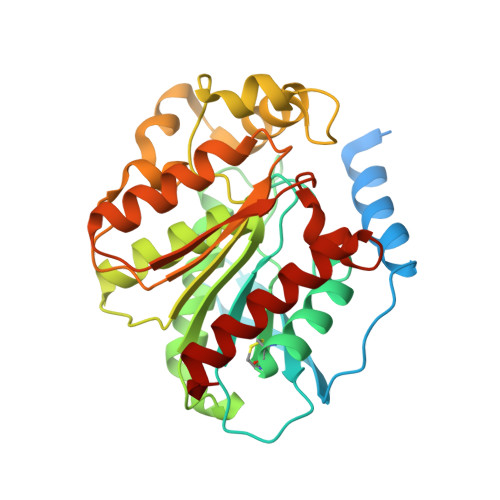Structure and stability of a thermostable carboxylesterase from the thermoacidophilic archaeon Sulfolobustokodaii
Angkawidjaja, C., Koga, Y., Takano, K., Kanaya, S.(2012) FEBS J 279: 3071-3084
- PubMed: 22748144
- DOI: https://doi.org/10.1111/j.1742-4658.2012.08687.x
- Primary Citation of Related Structures:
3AIK, 3AIL, 3AIM, 3AIN, 3AIO - PubMed Abstract:
The hormone-sensitive lipase (HSL) family is comprised of carboxylesterases and lipases with similarity to mammalian HSL. Thermophilic enzymes of this family have a high potential for use in biocatalysis. We prepared and crystallized a carboxylesterase of the HSL family from Sulfolobus tokodaii (Sto-Est), and determined its structures in the presence and absence of an inhibitor. Sto-Est forms a dimer in solution and the crystal structure suggests the presence of a stable biological dimer. We identified a residue close to the dimer interface, R267, which is conserved in archaeal enzymes of HSL family and is in close proximity to the same residue from the other monomer. Mutations of R267 to Glu, Gly and Lys were conducted and the resultant R267 mutants were characterized and crystallized. The structures of R267E, R267G and R267K are highly similar to that of Sto-Est with only slight differences in atomic coordinates. The dimerized states of R267E and R267G are unstable under denaturing conditions or at high temperature, as shown by a urea-induced dimer dissociation experiment and molecular dynamics simulation. R267E is the most unstable mutant protein, followed by R267G and R267K, as shown by the thermal denaturation curve and optimum temperature for activity. From the data, we discuss the importance of R267 in maintaining the dimer integrity of Sto-Est.
- Department of Material and Life Science, Graduate School of Engineering, Osaka University, Japan. clement@bio.mls.eng.osaka-u.ac.jp
Organizational Affiliation:



















